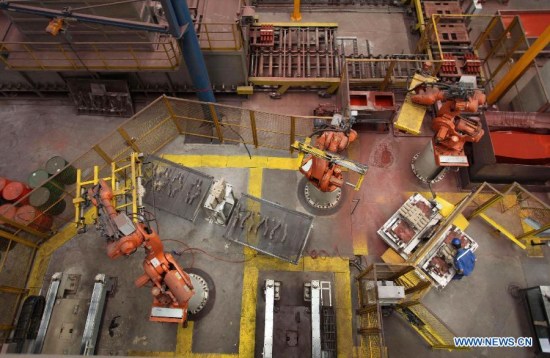
A man works in a workshop of the Foton auto company in the Shuangluan District of Chengde, north China's Hebei Province, Sept. 12, 2015. China's economy grew by 6.9 percent year on year in the first three quarters of 2015, according to figures issued by the National Bureau of Statistics on Oct. 19, 2015. (Photo: Xinhua/Wang Xiao)
The fundamentals of China's economy are unchanged, though the economy grew only 6.9 percent year on year in the third quarter, lower than 7 percent in the first half of the year.
In the first three quarters of the year, the GDP hit 48.78 trillion yuan (7.68 trillion U.S. dollars), up 6.9 percent year on year, according to the the National Bureau of Statistics on Monday.
This is the first time the quarterly growth rate has dropped below 7 percent since the second quarter of 2009.
This is the slowest pace of quarterly growth since the Global Financial Crisis, but it is better than consensus expectation and should allay some fears about a "hard-landing" in China, according to HSBC research.
The slowdown was mainly driven by a further weakening of the industrial sector, which saw deeper deflation. Service sector growth held up relatively well at the aggregate level, although financial sector contribution fell compared with the first half year in 2015.
Both industrial production and fixed asset investment growth slowed further. Sluggish domestic demand aside, the extra holiday and production shutdown ahead of the military parade may have also weighed on production. Meanwhile, both retail sales and property sales growth remained relatively strong.
The data point to some signs of stabilization in the Chinese economy, though challenges remain, according to HSBC research.
The data further supports President Xi Jinping's talks during his U.S. visit in late September that "China's economic fundamentals remain solid and will continue to maintain long-term steady growth."
He further made it clear in a written interview with Reuters on Sunday that "China's economic development is adjusting to the new normal and experiencing growing pains of shifting from old drivers of growth to new ones. Yet the fundamentals of a steadily growing economy have remained unchanged."
"The new type of industrialization, IT application, urbanization and agricultural modernization that is in full swing has generated strong domestic demand and great potential for future growth. It has also made the economy more resilient and adaptable. All this, coupled with deepening structural reforms, means that China will have very promising economic prospects," Xi said.
The Chinese economy grew by 7 percent in the first half of this year, which is consistent with the growth target of the whole year and is the fastest growth rate among major economies around the world.
It is normal that an economy may grow at different speeds in different periods. It would be against the law of economics to aim for ever higher growth without any slowing down, he said.
"The 7 percent growth in the first half of this year was achieved on the basis of an economy of over 10 trillion U.S. dollars. The increment is already equivalent to the annual GDP of a medium-sized country and still exceeds what was generated by double-digit growth several years ago," said Xi in his written interview with Reuters.
He vowed to "enhance macro regulation in creative ways to improve the quality and efficiency of economic development and address the lack of balance, coordination and sustainability in the economy."


















































